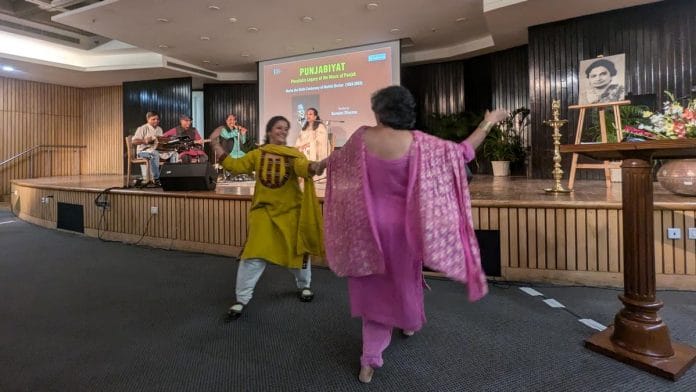New Delhi: Punjabi music doesn’t care about borders. It spills across them, breaks them, and dances on top of them. That spirit thrummed at the India International Centre as Sunaini Sharma—granddaughter of the legendary Lahore-born ‘Nightingale of Punjab’ Surinder Kaur—had the crowd clapping and tapping their feet to her Punjabi folk songs.
“You can take a girl out of Punjab, but you cannot take Punjab out of a girl,” said Sharma, after launching into a set that included popular folk songs, like Jugni and Lathe Di Chadar, famously reimagined in ‘London Thumakda’ from Queen. A few women in the audience couldn’t help themselves—they got up and danced.
The 23 November event, titled Punjabiyat: Pluralistic Legacy of the Music of Punjab, celebrated the enduring essence of Punjabi culture—its music, its ethos, and its resilience across borders. The audience of 80 to 100 people leaned older, with many seeming to appreciate the broader meaning behind the performance.
Apart from the mics and instruments for the performance, the stage featured a black-and-white portrait of Mohini Borker nee Bhagat (1924-2003)—a pioneer of Indo-Pak cultural amity and the evening’s inspiration. The music performance was part of a series to mark Borker’s birth centenary. A staunch advocate for cross-border peace and general secretary of the Kinnaird College Alumni Association in India for 45 years, she was known for her work in promoting cultural exchange between India and Pakistan.
As it happened, singer Sharma, who is also a Punjabi ethnomusicologist, had returned from a trip from Lahore through the Wagah Border herself for this performance.
Through songs and commentary, Sharma, along with the keynote speakers—author and historian Biba Sobti and filmmaker and IIC trustee Suhas Borker—explored the concept of Punjabiyat—a cultural identity that transcends nationality, class, religion, and geography.
“There is east Punjab on one side, and west Punjab on the other, and now there is a binding element which has emerged worldwide, which is the Punjabi diaspora. That has given a new meaning to Punjabiyat,” said Suhas Borker, Mohini Borker’s son. “Punjabis from India and Pakistan, they are the same, they gel very much, I have seen that happen myself.”
Also Read: Hip-hop did not drown out Punjab’s Nightingale Surinder Kaur and her love songs
Philosophy of Punjabiyat
Punjabiyat isn’t just about shared histories of political struggles and collective memories. It’s also encapsulated in “popular art, music, and literature,” according to Borker.
He credited the Gurmat and Sufi traditions of Punjab for shaping an inclusive identity that embraces plurality. The Adi Granth, the primary scripture of the Sikhs, exemplifies this spirit, he added, by including the teachings of not just the Sikh gurus but also those of saints like Kabir and Ravidas.
Punjabiyat, in essence, shares common ground with Ganga-Jamuni Tehzeeb, a tradition of blending Hindu and Muslim cultures in the northern plains.
“When you look at Urdu, it is basically the same as Hindi,” pointed out a member of the audience. Punjabi is also written in more than one script. Here it is written in Gurumukhi, there [Pakistan] it is written in Shahmukhi or what is called, ‘Urdu script,’ but the language is the same.”
For Sunaini Sharma, the challenge lies in keeping Punjabiyat alive while balancing parampara (tradition) and modernity.

“I have never studied Punjabi. I have a master’s in English literature and lived most of my life in the US,” she said. “We were in that post-colonial era, where our parents felt it was very important for us to learn English and be global citizens—but this alienated us from our Punjabiyat.”
Sharma called for an education system that embraces linguistic and cultural diversity.
“Why doesn’t our education system have the capacity to teach children 7-8 languages? Why do we settle for 2-3 languages? Why are we restricted when it comes to languages?” she asked, switching seamlessly between Punjabi and English as she spoke.
Punjabi Sufi poetry should be taught in schools, according to her, and given the same prominence as the Bhakti movement. She also pointed out that Sufism, Persian music, and Hindustani music all play a part in the Punjabi cultural landscape.
“Music is not a co-curricular activity; music is the mainstream activity of your life,” Sharma said. “You are constantly in the musicality of your life. The peace that we seek within happens so organically with music.”
Also Read: Historians have given ‘marginal treatment’ to Punjab. A new book fills the gap
Nostalgia and the new
Sunaini Sharma’s performance travelled through the many moods of Punjabiyat, beginning with a meditative jaap of Satnaam Shri Waheguru Sahebji. From there, she shifted gears to upbeat folk songs and even qawwali.
The audience lit up during nostalgic classics like Munda Lambda Da, famously rendered by Sharma’s grandmother Surinder Kaur, and Chitta Kukkar, a wedding favourite first recorded by Pakistani singer Musarrat Nazir. Noor Jehan’s Udda Dupatta Mera Malmal Da also drew an enthusiastic response while Bajre Da Sitta—recently given a hip-hop spin by pop artist Rashmeet Kaur—resonated with younger listeners.
Backing her vocals were Veval Sharma on flute, Surinder Singh on guitar, and Karam Chand on percussion, adding to the expressiveness of the performance.
Sharma closed the evening with Damadam Mast Qalandar, dedicating it to the Sufi poets who have left their imprint on Punjabi culture. She prefaced it with a doha by Kabir: Lali mere lal ki, jit dekhoun tit lal… lali dekhan mai gayi, mai bhi ho gayi lal (The divinity of my beloved is everywhere I look… I went to see His divinity, and then I, too, turned divine).
“This will take you from Kabir Math in Uttar Pradesh to Sindh in a fraction of a second, so fasten your seatbelts,” she said, as the audience swayed and sang along.
(Edited by Asavari Singh)







Those who long for Pakistan are free to go back to Pakistan. They need not stay in India.
This idiotic “peace brigade” must be socially and politically ostracized.